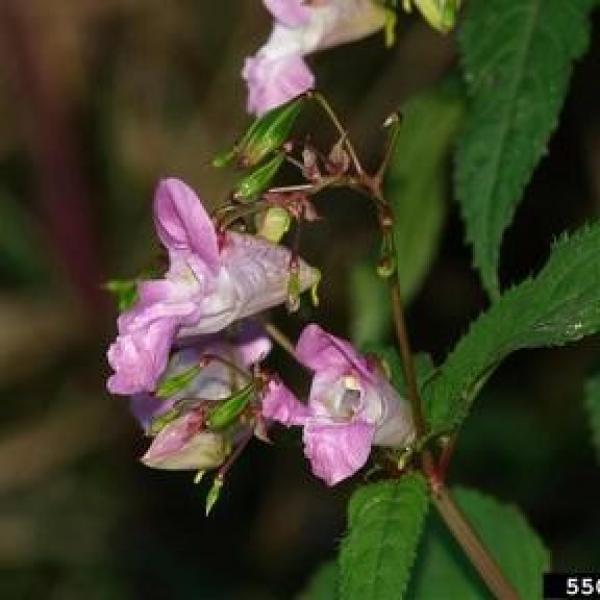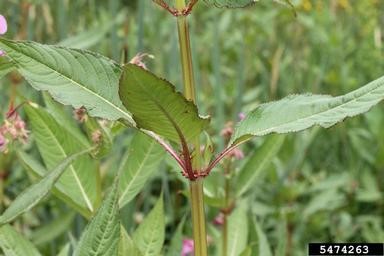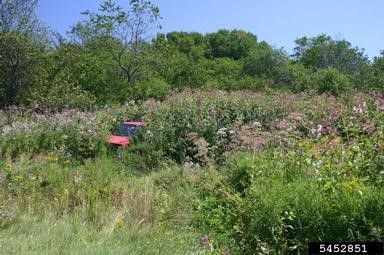
Author: Elizabeth Spinney, Invasive Plant Coordinator, Vermont Department of Forests, Parks & Recreation
Short, snow-filled days have been with us for a while now this winter, and it can feel hard to believe that things will be green again soon. The amount of effort I’m putting into bundling up to get outside each day is perhaps a testament to my lack of “cold tolerance”. Cold tolerance can be a feature that us gardeners in northern states seek out in new plants for our yards, but also something we should be aware could be a warning sign of a potentially invasive plant.
Plants that become invasive can tolerate a spectrum of growing conditions, whether its Phragmites breaking through pavement, or barberry growing large even under full forest canopy, or knotweed growing in a rock pile out behind a garage, or purple loosestrife poking up in ditches, getting covered in road runoff. This article will focus on a cold-tolerant non-native invasive plant called Himalayan Balsam (Impatiens glandulifera).
A member of the “touch-me-not” family (Balsaminaceae), Himalayan balsam also known as Indian balsam, Himalayan touch-me-not, Himalayan jewelweed, ornamental jewelweed, Pink jewelweed, Purple jewelweed, gnome’s hat stand, and kiss-me-on-the-mountain, among others, is native to central Asia, and was originally brought to Europe in the mid 1800’s. It has frequently escaped cultivation, now being present throughout continental Europe, throughout the UK, in most Canadian provinces, New England and the West Coast. Himalayan balsam prefers sites with wetter soils, and is commonly found in ditches, roadsides, railroad ROW, yards and gardens, but also along streams, floodplain forests, meadows, fields, early successional forests, and edge communities.
Leaves of Himalayan balsam are oblong with sharply serrated edges and a red midrib (midrib = vein that divides leaf in two). The leaves appear in pairs or whorled around the stem. The stems are hollow and can have a red/purple tint. Mature plants reach 6+ ft in a year (annual). This species produces 800-2,000+ seeds per individual, and the seeds are found in small pods that burst open when touched. High reproductive output, along with its significant height allows it to quickly outcompete native plants. The impact it has had in other northern states and provinces has led to its listing on the unofficial invasive plant watch list in Vermont, meaning the plant has invasive tendencies, but is not yet prohibited. Additionally, this plant is considered an early detection invasive species in Vermont, as there are several accounts of this plant in the state, but it is not yet well established.

Impatiens glandulifera (Himalayan balsam) showing characteristic leaves in whorls of 3. Photo: Rob Routledge, Sault College, Bugwood.org
The best time to identify this plant is during the summer and early fall, when it is flowering. Native look-a-likes, Pale Jewelweed

Impatiens glandulifera (Himalayan balsam) infestation. Photo: Leslie J. Mehrhoff, University of Connecticut, Bugwood.org
(Impatiens pallida) and Jewelweed (Impatiens capensis) can be distinguished from their invasive cousin most easily by flower color (native jewelweeds/touch-me-nots have yellow and orange hued flowers, invasive Himalayan balsam has pink or purple flowers).
To learn more about Himalayan balsam, check out www.VTinvasives.org and these additional resources:
- VT FPR Watch List
- Michigan Invasive Species Alert
- Langley Environmental Partners Society Fact Sheet
- GoBotany
- Maine Natural Areas Program
- Invasive Species Centre
- Washington State Noxious Weed Control Board
- eXtension
Photo top right: Himalayan Balsam Flowers, Becca MacDonald, Sault College, Bugwood.org